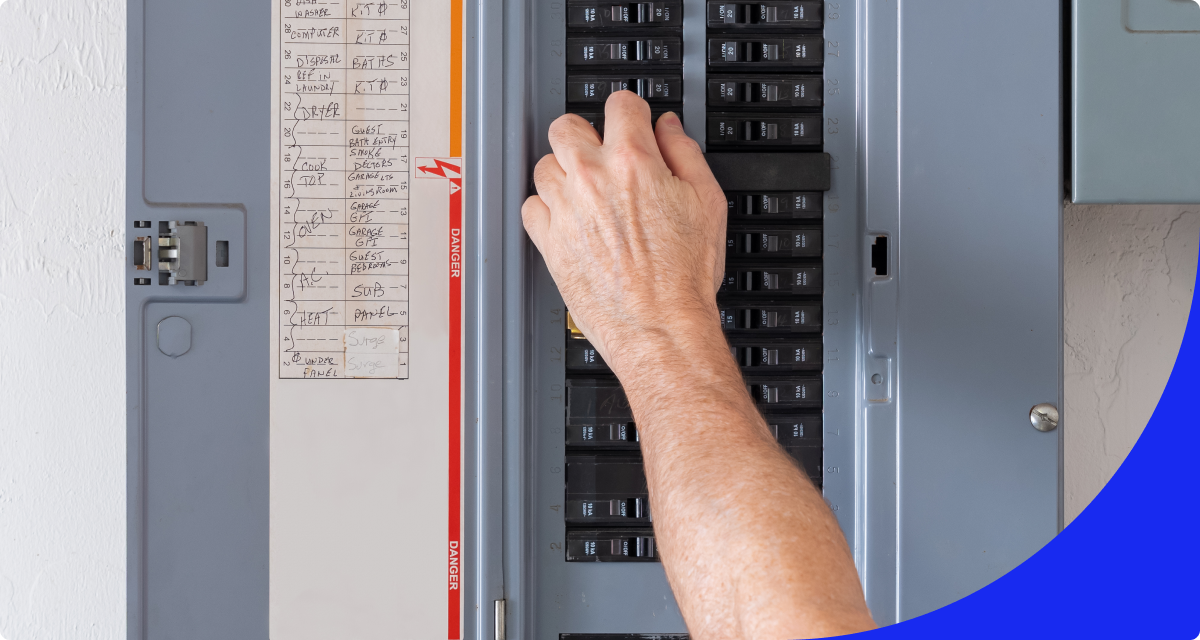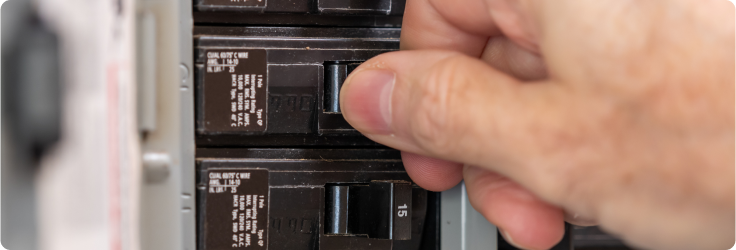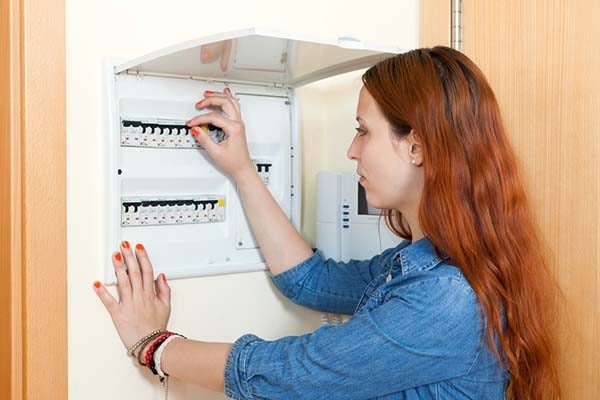Turn off the problem circuit
Locate your electrical panel and identify the breaker that corresponds to the overloaded circuit. Switch it off to cut the power and reduce the risk of further damage or fire.
You want your home to be as safe as possible. And while you make every effort to turn off the stove when you’re done cooking, regularly check your smoke detectors, and maintain your fire extinguishers, there could be a hidden danger lurking in your walls: an overloaded circuit.

In case you’re unfamiliar with the idea of a circuit, it’s quite simple: When power comes into your home, it’s directed to your electrical panel (also called your breaker box). From there, it’s redirected into multiple sections of your home through a collection of wires and back to the breaker box through “circuits.”
Most homes today have around 5 or 10 circuits, but yours could have more or less depending on the size. Since these circuits are responsible for transporting electricity, a problem in one of the circuits can lead to serious issues—including house fires.
One of the most common causes for concern is an overloaded circuit. Read on to learn more!

An overloaded circuit occurs when there’s too much electricity passing through it—essentially, more demand than it can handle. When there’s too much power demand, the circuit may overheat and could potentially even cause a fire. That’s why room circuit overload is so dangerous!
An overloaded circuit can have numerous causes. Some of the most common culprits:
Understanding what causes an overloaded circuit can help you prevent dangerous scenarios in the future.
Although an overloaded outlet can become a deadly hazard if ignored, you’ll usually have multiple warning signs before disaster strikes. Evidence of an overloaded circuit:
If you suspect an overloaded circuit in your home, it’s important to address the issue promptly to ensure safety. Here’s a step-by-step guide to fixing an overloaded circuit:
Locate your electrical panel and identify the breaker that corresponds to the overloaded circuit. Switch it off to cut the power and reduce the risk of further damage or fire.
Disconnect all devices and appliances from outlets on the circuit. This will help you isolate what’s causing the overload.
Once you’ve removed the load, reset the circuit breaker by flipping it back to the “on” position. If the breaker trips again immediately, there may be a deeper electrical issue requiring professional assistance.
After resetting the circuit, reconnect devices one at a time. Spread high-energy appliances (like space heaters, refrigerators, or microwaves) across multiple circuits if possible. Avoid plugging too many devices into the same outlets.
Sometimes the problem isn’t the circuit itself but a faulty appliance or device. Inspect each item you unplugged for signs of damage, such as frayed cords or unusual odors, before plugging them back in.
If you cannot identify the cause of the overload or if the problem persists, call a licensed electrician—or request service if you’re an American Home Shield® customer. They can help diagnose and fix the covered issue, whether it’s outdated wiring, a damaged circuit, or an undersized electrical panel.
See how a protection plan can help with covered circuit issues.

Prevention is always better than a cure. These tips will help you reduce the likelihood of an overloaded circuit in your home:
Avoid plugging multiple high-energy devices (like hair dryers, air fryers, or gaming consoles) into the same circuit. Use outlets on different circuits to balance the electrical load.
Invest in surge protectors or power strips with built-in circuit breakers. These tools can help prevent overloads by limiting the electricity flow and shutting off power when necessary.
Older homes may have outdated wiring that isn’t designed to handle modern electrical demands. Upgrading to newer wiring can improve your system’s capacity and reduce the risk of overload.
If your home frequently experiences overloads, consider having an electrician install additional circuits. This is especially important for rooms with heavy power usage, like kitchens or home offices, in which it might be especially dangerous to experience a room circuit overload.
Plugging one extension cord into another can create a fire hazard and increase the risk of overloading the circuit. Use a single, heavy-duty cord for each device or appliance.
If your breaker box is outdated or cannot handle the power demands of your home, upgrade to a modern electrical panel. A new panel will better distribute electricity and prevent overloads.
Be mindful of the total wattage you’re drawing from a circuit. If you’re unsure of the limits, consult an electrician for an energy audit.
Having a professional inspect your electrical system every few years can help identify and address potential issues before they become dangerous.
Fixing and preventing the overloading of circuits is just one piece of keeping your home’s electrical system stay in tip-top shape. If you need broader support, look no further than an American Home Shield home warranty plan.
With a range of coverage options for your home’s major systems and appliances—including your electrical system—you’ll gain peace of mind knowing unexpected covered breakdowns won’t catch you off guard.